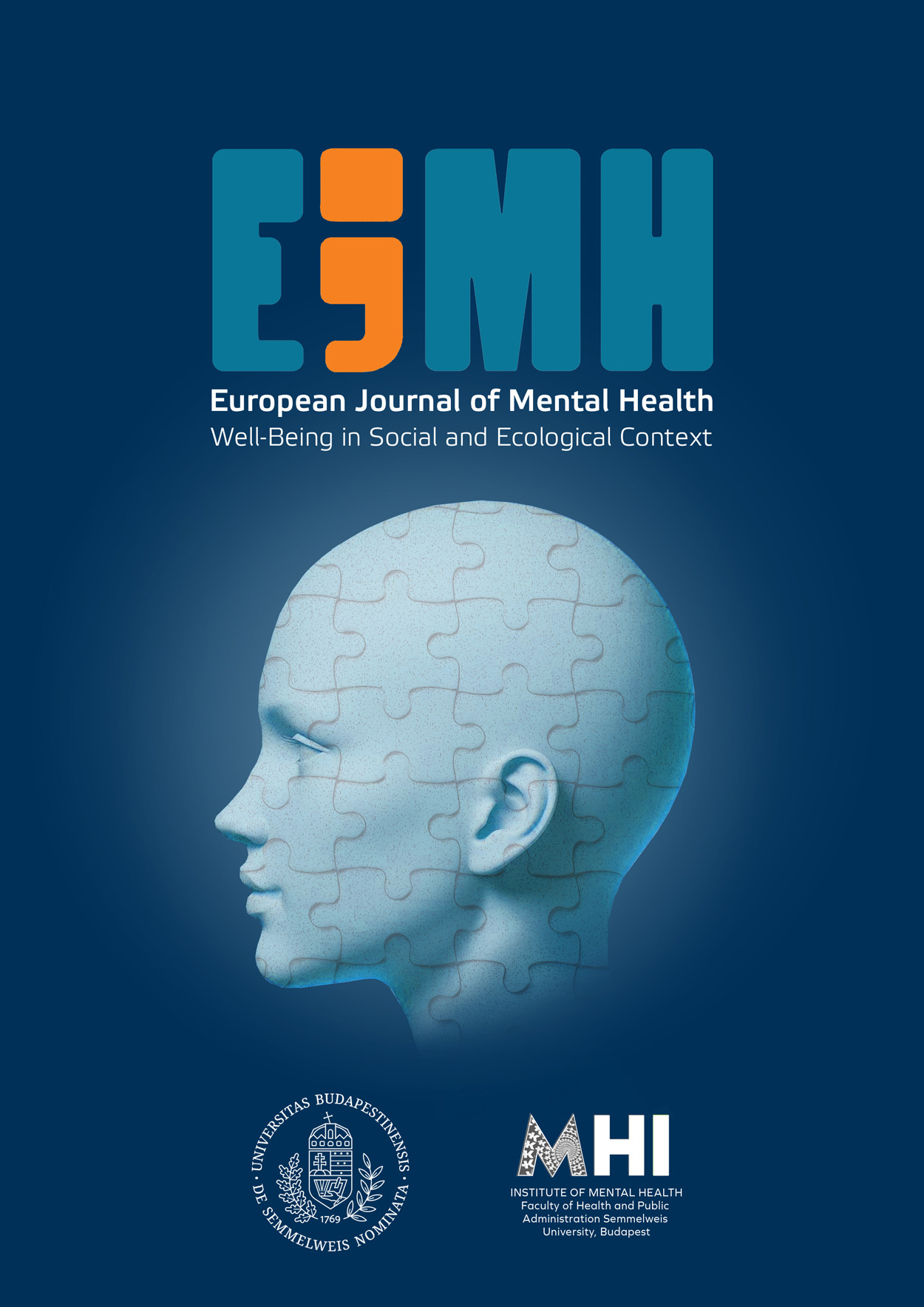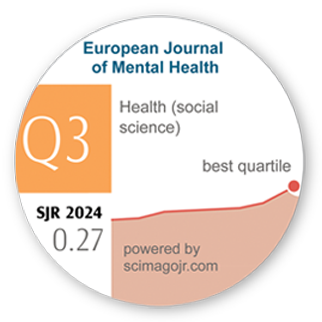Exploring Awareness and Resistance to Nonattachment in Relation to Mental Health. A Qualitative Study in a UK-Based Yoga Community
DOI:
https://doi.org/10.5708/EJMH.18.2023.0011Keywords:
nonattachment, surrender, reflexive thematic analysis, mental healthAbstract
Introduction: Nonattachment is a flexible and balanced way of relating to experiences that involves accepting or allowing, instead of clinging to, expectations or outcomes. Advancing the understanding of how people relate to nonattachment is important because of the associated mental health benefits.
Aims: To qualitatively explore awareness of, and resistance to, nonattachment in a UK-based yoga community.
Methods: A reflexive thematic analysis was conducted based on transcripts of ten semi-structured interviews.
Results: Findings indicated a general lack of consensus in understanding nonattachment, with explanatory themes of (i) resistance related to external forces conflicting with internal knowing, (ii) bracing for impact, and (iii) difficulty navigating how to embrace nonattachment. However, despite the participants’ apparent implicit negativity towards nonattachment, they acknowledged its benefits for accommodating change.
Conclusions: These findings have important implications for the wider adoption and application of nonattachment in applied settings.
References
Ainsworth, M. D. S. (1978). Patterns of attachment: A psychological study of the strange situation.
Lawrence Erlbaum Associates; Distributed by Halsted Press Division of Wiley.
Ainsworth, M. D. S. (2015). Patterns of attachment: A psychological study of the strange situation
(Classic edition). Psychology Press and Routledge classic editions. Routledge.
Archibald, M. M., Ambagtsheer, R. C., Casey, M. G., & Lawless, M. (2019). Using Zoom
Videoconferencing for Qualitative Data Collection: Perceptions and Experiences of Researchers and Participants. International Journal of Qualitative Methods, 18, Article 160940691987459.
https://doi.org/10.1177/1609406919874596
Ardelt, M., & Grunwald, S. (2018). The Importance of Self-Reflection and Awareness for Human
Development in Hard Times. Research in Human Development, 15(3–4), 187–199.
https://doi.org/10.1080/15427609.2018.1489098
Baker, C., & Kirk-Wade, E. (2023) Mental health statistics: prevalence, services and funding in England. House of Commons Library
Barrows, P. D., Richardson, M., Hamlin, I., & Van Gordon, W. (2022). Nature Connectedness,
Nonattachment, and Engagement with Nature's Beauty Predict Pro-Nature Conservation Behavior. Ecopsychology, 14(2), 83–91
https://doi.org/10.1089/eco.2021.0036
Bem, D. J. (1972). Self-Perception Theory. Advances in Experimental Social Psychology, 6, 1–62.
https://doi.org/10.1016/S0065-2601(08)60024-6
Bowlby, J. (1982). Attachment and loss: Retrospect and prospect. The American Journal of Orthopsychiatry, 52(4), 664–678.
https://doi.org/10.1111/j.1939-0025.1982.tb01456.x
Bowlby, J. (1998). Attachment and loss. Pimlico.
Bowlby, R. (2004). Fifty years of attachment theory. Karnac Books.
Braun, V., & Clarke, V. (2006). Using Thematic Analysis in psychology. Qualitative Research in Psychology, 3(2), 77–101.
https://doi.org/10.1191/1478088706qp063oa
Braun, V., & Clarke, V. (2019). Reflecting on reflexive thematic analysis. Qualitative Research in Sport, Exercise and Health, 11(4), 589–597.
https://doi.org/10.1080/2159676X.2019.1628806
Braun, V., & Clarke, V. (2021). Thematic Analysis: A practical guide to understanding and doing Sage.
Burr, V. (2015). Social constructionism (3rd ed.). Routledge.
Cebolla, A., Galiana, L., Campos, D., Oliver, A., Soler, J., Demarzo, M., Baños, R. M., Feliu-Soler, A., & García-Campayo, J. (2018). How Does Mindfulness Work? Exploring a Theoretical Model Using Samples of Meditators and Non-meditators. Mindfulness, 9(3), 860–870.
https://doi.org/10.1007/s12671-017-0826-7
Chao, S.‑H., & Chen, P.‑H. (2013). The reliability and validity of the Chinese version of the Nonattachment Scale: Reliability, validity, and its relationship with mental health. Bulletin of Educational Psychology, 45(1), 121–139.
Cheung, K., Taillieu, T., Turner, S., Fortier, J., Sareen, J., MacMillan, H. L., Boyle, M. H., &
Afifi, T. O. (2017). Relationship and community factors related to better mental health following child maltreatment among adolescents. Child Abuse & Neglect, 70, 377–387.
https://doi.org/10.1016/j.chiabu.2017.06.026
Chio, F. H. N., Lai, M. H. C., & Mak, W. W. S. (2018). Development of the Nonattachment Scale-Short Form (NAS-SF) Using Item Response Theory. Mindfulness, 9(4), 1299–1308.
https://doi.org/10.1007/s12671-017-0874-z
Cixous, H. (1997). Sorties: Out and out: Attacks/ways out/forays. The logic of the gift: Towards an ethic of generosity, 148–173.
Clark, F., Sanders, K., Carlson, M., Blanche, E., & Jackson, J. (2007). Synthesis of Habit Theory.
OTJR: Occupational Therapy Journal of Research, 27(1_suppl), 7S-23S.
https://doi.org/10.1177/15394492070270S103
Coffey, K. A., & Hartman, M. (2008). Mechanisms of Action in the Inverse Relationship Between Mindfulness and Psychological Distress. Complementary Health Practice Review, 13(2), 79–91.
https://doi.org/10.1177/1533210108316307
Colston, H. L. (2019). How language makes meaning: Embodiment and conjoined antonymy / Herbert L. Colston. Cambridge University Press.
Costandi, M. (2016). Neuroplasticity. The MIT Press essential knowledge series. The MIT Press.
Dannefer, D. (1984). Adult Development and Social Theory: A Paradigmatic Reappraisal. American Sociological Review, 49(1), 100–116.
https://doi.org/10.2307/2095560
Dannefer, D. (2015). Right in Front of Us: Taking Everyday Life Seriously in the Study of Human Development. Research in Human Development, 12(3–4), 209–216. https://doi.org/10.1080/15427609.2015.1068043
Darlington, Y., & Scott, D. (2002). Qualitative research in practice. Stories from the Field 2nd Edition. Journal of Orthopaedic Nursing, 6(4), 237–238.
https://doi.org/10.1016/S1361-3111(02)00100-0
Dawkins, R. (2008). The God delusion (1st Mariner Books ed.). Houghton Mifflin Co.
Department of Health (2011). No health without mental health: A cross- government mental health outcomes strategy for people of all ages. Retrieved February 23, 2022, from
https://assets.publishing.service.gov.uk/government/uploads/system/uploads/attachment_data/file/215808/dh_123993.pdf
Derricourt, R. M. (2021). Creating God: The birth and growth of major religions / Robin Derricourt. Manchester University Press.
Domhoff, G.W. (2018). Who Rules America? : Power and Politics. In D. Grusky, D. B. Grusky, & S. Szelényi (Eds.), The Inequality Reader: Contemporary and foundational readings in race, class, and gender (pp. 112–117). Routledge.
https://doi.org/10.4324/9780429494468-12
Dvorak, R. D., Lamis, D. A., & Malone, P. S. (2013). Alcohol use, depressive symptoms, and impulsivity as risk factors for suicide proneness among college students. Journal of Affective Disorders, 149(1–3), 326–334.
https://doi.org/10.1016/j.jad.2013.01.046
Elphinstone, B., Sahdra, B. K., & Ciarrochi, J. (2020). Living well by letting go: Reliability and validity of a brief measure of nonattachment. Advance online publication.
https://doi.org/10.31219/osf.io/ew4ns
Elphinstone, B., & Whitehead, R. (2019). The benefits of being less fixated on self and stuff: Nonattachment, reduced insecurity, and reduced materialism. Personality and Individual Differences, 149, 302–308.
https://doi.org/10.1016/j.paid.2019.06.019
Erikson, E. H. (1963). Childhood and society. Norton.
Feliu-Soler, A., Soler, J., Luciano, J. V., Cebolla, A., Elices, M., Demarzo, M., & García-Campayo, J. (2016). Psychometric Properties of the Spanish Version of the Nonattachment Scale (NAS) and Its Relationship with Mindfulness, Decentering, and Mental Health. Mindfulness, 7(5), 1156–1169.
https://doi.org/10.1007/s12671-016-0558-0
Finn, R. D. (2009). Asceticism in the Graeco-Roman world. Key themes in ancient history. Cambridge University Press.
Ghent, E. (1990). Masochism, Submission, Surrender. Contemporary Psychoanalysis, 26(1), 108-136
Guest, G., MacQueen, K. M., & Namey, E. E. (2012). Applied Thematic Analysis. Sage.
https://doi.org/10.1080/00107530.1990.10746643
Gupta, K. & Agrawal, J. (2022). An empirical study of ancient wisdom. Effect of Anasakti (Non-Attachment) and Ahamkara (Ego) on well-being amongst Indians. European Journal of Mental Health, 17(3), 78–95.
https://doi.org/10.5708/EJMH.17.2022.3.6
Hagerty, B. M., Lynch-Sauer, J., Patusky, K. L., Bouwsema, M., & Collier, P. (1992). Sense of belonging: A vital mental health concept. Archives of Psychiatric Nursing, 6(3), 172–177.
https://doi.org/10.1016/0883-9417(92)90028-H
Hagger, M. S. (2018). Habit and Physical Activity: Theoretical Advances, Practical Implications, and Agenda for Future Research. Advance online publication.
https://doi.org/10.31234/osf.io/4ge57
Hamedani, M. Y. G., & Markus, H. R. (2019). Understanding Culture Clashes and Catalyzing Change: A Culture Cycle Approach. Frontiers in Psychology, 10, 700.
https://doi.org/10.3389/fpsyg.2019.00700
Hạnh, N. (1999). The heart of the Buddha's teaching: Transforming suffering into peace, joy & liberation the four noble truths, the noble eightfold path, and other basic Buddhist teachings (1st Broadway Books trade pbk. ed.). Broadway Books.
Harry, B., & Lipsky, M. (2014). Qualitative Research on Special Education Teacher Preparation.
In M. McCray, T. Brownell, & B. Lignugaris/Kraft (Eds.), Handbook of research on special education teacher preparation (pp. 445–460). Routledge.
Hidas, A. (1981). Psychotherapy and surrender: A psychospiritual perspective.
https://www.atpweb.org/jtparchive/trps-13-81-01-027.pdf
Hill, D. L. (2006). Sense of belonging as connectedness, American Indian worldview, and mental health. Archives of Psychiatric Nursing, 20(5), 210–216.
https://doi.org/10.1016/j.apnu.2006.04.003
Hitchens, C. (2008). God is not great: How religion poisons everything / Christopher Hitchens. Atlantic Books.
Ho, C. Y., Ben, C. L., & Mak, W. W. (2022). Nonattachment mediates the associations between mindfulness, well-being, and psychological distress: A meta-analytic structural equation modeling approach. Clinical Psychology Review, 95, Article 102175.
https://doi.org/10.1016/j.cpr.2022.102175
Horan, R. (2011). Spirituality. In Mark A. Runco, M. A., & Pritzker, S. R. (Eds.), Encyclopedia of Creativity (2nd ed.) pp 364–372. Academic Press.
https://doi.org/10.1016/B978-0-12-375038-9.00206-5
Jones, S. (2007). ‘Opposites’ in discourse: A comparison of antonym use across four domains. Journal of Pragmatics, 39(6), 1105–1119.
https://doi.org/10.1016/j.pragma.2006.11.019
Joss, D., Lazar, S. W., & Teicher, M. H. (2020). Nonattachment Predicts Empathy, RejectionSensitivity, and Symptom Reduction After a Mindfulness-Based Intervention Among Young Adults with a History of Childhood Maltreatment. Mindfulness, 11(4), 975–990.
https://doi.org/10.1007/s12671-020-01322-9
Kim, Y. J., van Rooij, S. J. H., Ely, T. D., Fani, N., Ressler, K. J., Jovanovic, T., & Stevens, J. S. (2019). Association between posttraumatic stress disorder severity and amygdala habituation to fearful stimuli. Depression and Anxiety, 36(7), 647–658.
https://doi.org/10.1002/da.22928
Kimble, M. O., Fleming, K., & Bennion, K. A. (2013). Contributors to hypervigilance in a military and civilian sample. Journal of Interpersonal Violence, 28(8), 1672–1692.
https://doi.org/10.1177/0886260512468319
Kleshchova, O., Rieder, J. K., Grinband, J., & Weierich, M. R. (2019). Resting amygdala connectivity and basal sympathetic tone as markers of chronic hypervigilance. Psychoneuroendocrinology, 102, 68–78.
https://doi.org/10.1016/j.psyneuen.2018.11.036
Lasswell, H. D., & Kaplan, A. (2017). Power And Society. Routledge.
https://doi.org/10.4324/9781315127156
Lawrenz, J. (2021). Confucius, Aristotle, and the Golden Mean: A Diptych on Ethical Virtues. The European Legacy, 26(2), 149–169.
https://doi.org/10.1080/10848770.2020.1823622
Levenson, M. R., Aldwin, C. M., & Cupertino, A. P. (2001). Transcending the self: Towards a Liberative Model of adult development. Maturidade & Velhice: Um Enfoque Multidisciplinar, 99–116.
https://www.researchgate.net/publication/254912263_Transcending_the_Self_Toward_a_Liberative_Model_of_Adult_Development
Levenson, M. R., & Crumpler, C. A. (1996). Three Models of Adult Development. Human Development, 39(3), 135–149.
https://doi.org/10.1159/000278429
Levitt, H. M., Bamberg, M., Creswell, J. W., Frost, D. M., Josselson, R., & Suárez-Orozco, C.
(2018). Journal article reporting standards for qualitative primary, qualitative meta-analytic, and mixed methods research in psychology: The APA Publications and Communications Board task force report. American Psychologist, 73(1), 26–46.
https://doi.org/10.1037/amp0000151
Mahlo, L., & Windsor, T. D. (2021). Older and more mindful? Age differences in mindfulness components and well-being. Aging & Mental Health, 25(7), 1320–1331.
https://doi.org/10.1080/13607863.2020.1734915
Markus, H. R., & Conner, A. (2014). Clash! How to Thrive in a Multicultural World. Penguin.
Morris, M. W., Chiu, C., & Liu, Z. (2015). Polycultural psychology. Annual Review of Psychology, 66, 631–659.
https://doi.org/10.1146/annurev-psych-010814-015001
NHS (2017). NHS Mental Health Dashboard. NHS choices. Retrieved February 23, 2022, from
https://www.england.nhs.uk/publication/nhs-mental-health-dashboard/
Nilsen, P., Roback, K., Broström, A., & Ellström, P.‑E. (2012). Creatures of habit: Accounting for the role of habit in implementation research on clinical behaviour change. Implementation Science, 7, Article 53.
https://doi.org/10.1186/1748-5908-7-53
Parkin, S. S., Jarman, M. S., & Vallacher, R. R. (2015). On Being Mindful: What Do People Think They're Doing? Social and Personality Psychology Compass, 9(1), 31–44.
https://doi.org/10.1111/spc3.12156
Phillips, N., & Hardy, C. (2002). Discourse Analysis (1st ed.). SAGE Publications. Prebish, C. S. (1975). [Review of Cutting through Spiritual Materialism, by C. Trungpa, J. Baker, M. Casper]. Journal of the American Academy of Religion, 43(2), 337–338.
http://www.jstor.org/stable/1461218
Rahman, M. S. (2016). The Advantages and Disadvantages of Using Qualitative and Quantitative Approaches and Methods in Language “Testing and Assessment” Research: A Literature Review. Journal of Education and Learning, 6(1), Article 102.
https://doi.org/10.5539/jel.v6n1p102
Ross, C. E. (1990). Religion and Psychological Distress. Journal for the Scientific Study of Religion, 29(2), 236–245.
https://doi.org/10.2307/1387431
Russell, J. A., Fernández-Dols, J.‑M., Manstead, A. S., & Wellenkamp, J. C. (2013). Everyday Conceptions of Emotion: An Introduction to the Psychology, Anthropology and Linguistics of Emotion. Springer Science & Business Media.
Sahdra, B., Ciarrochi, J., & Parker, P. (2016). Nonattachment and mindfulness: Related but distinct constructs. Psychological Assessment, 28(7), 819–829.
https://doi.org/10.1037/pas0000264
Sahdra, B. K., Ciarrochi, J., Parker, P. D., Marshall, S., & Heaven, P. (2015). Empathy and nonattachment independently predict peer nominations of prosocial behavior of adolescents. Frontiers in Psychology, 6, Article 263.
https://doi.org/10.3389/fpsyg.2015.00263
Sahdra, B. K., Shaver, P. R., & Brown, K. W. (2010). A scale to measure nonattachment: A Buddhist complement to Western research on attachment and adaptive functioning. Journal of Personality Assessment, 92(2), 116–127.
https://doi.org/10.1080/00223890903425960
Sethi, M. (2009). Chastity and desire: Representing women in Jainism. South Asian History and Culture, 1(1), 42–59.
https://doi.org/10.1080/19472490903387209
Shonin, E., & Van Gordon, W. (2013). Searching for the present moment, Mindfulness, 5, 105–107
http://dx.doi.org/10.1007/s12671-013-0248-0
Shonin, E., Van Gordon W., & Griffiths, M. D. (2014). The emerging role of Buddhism in clinical psychology: Towards effective integration. Psychology of Religion and Spirituality, 6, 123–137.
http://dx.doi.org/10.1037/a0035859
Silverman, D. (2014). Interpreting qualitative data (Fifth edition). Sage.
Simonsson, O., Fisher, S., & Martin, M. (2021). Awareness and Experience of Mindfulness in Britain. Sociological Research Online, 26(4), 833–852.
https://doi.org/10.1177/1360780420980761
Sosa, E. (2017). Epistemology. Princeton University Press.
https://doi.org/10.1515/9781400883059
Tran, U. S., Cebolla, A., Glück, T. M., Soler, J., Garcia-Campayo, J., & Moy, T. von (2014). The serenity of the meditating mind: A cross-cultural psychometric study on a two-factor higher order structure of mindfulness, its effects, and mechanisms related to mental health among experienced meditators. PLoS ONE, 9(10), e110192.
https://doi.org/10.1371/journal.pone.0110192
UkPublicSpending.co.uk. (2022). What is the total UK public spending? Charts of Current Spending. Retrieved February 23, 2022, from
https://www.ukpublicspending.co.uk/current_spending
Vallacher, R. R., & Wegner, D. M. (1987). What do people think they're doing? Action identification and human behavior. Psychological Review, 94(1), 3–15.
https://doi.org/10.1037/0033-295X.94.1.3
Van Gordon, W., Shonin, E., Dunn, T. J., Garcia-Campayo, J., & Griffiths, M. D. (2017). Meditation awareness training for the treatment of fibromyalgia syndrome: A randomized controlled trial. British Journal of Health Psychology, 22(1), 186–206.
https://doi.org/10.1111/bjhp.12224
Van Gordon, W., Shonin, E., & Griffiths, M. D. (2016). Meditation Awareness Training for individuals with fibromyalgia syndrome: An interpretative phenomenological analysis of participant’s experiences. Mindfulness, 7(2), 409–419.
https://doi.org/10.1007/s12671-015-0458-8
Van Gordon, W., Shonin, E., Dunn, T. J., Sapthiang, S., Kotera, Y., Garcia-Campayo, J., & Sheffield, D. (2019). Exploring Emptiness and its Effects on Non-attachment, Mystical Experiences, and Psycho-spiritual Wellbeing: A Quantitative and Qualitative Study of Advanced Meditators. Explore, 15(4), 261–272.
https://doi.org/10.1016/j.explore.2018.12.003
Wang, S.‑Y., Wong, Y. J., & Yeh, K.‑H. (2016). Relationship Harmony, Dialectical Coping, and Nonattachment: Chinese Indigenous Well-Being and Mental Health. The Counseling Psychologist, 44(1), 78–108.
https://doi.org/10.1177/0011000015616463
Whitehead, R. (2019). Nonattachment and nonattachment to self: The role of letting go in optimal psychological health. Retrieved February 23, 2022, from
https://researchbank.swinburne.edu.au/file/903421cb-905f-4118-a417-7ce9d2fe331b/1/richard_whitehead_thesis.pdf
Whitehead, R., Bates, G., & Elphinstone, B., (2020). Growing by Letting Go: Nonattachment and Mindfulness as Qualities of Advanced Psychological Development. Journal of Adult Development, 27(1), 12–22.
https://doi.org/10.1007/s10804-018-09326-5
Whitehead, R., Bates, G., Elphinstone, B., Yang, Y., & Murray, G. (2018a). Letting Go of Self: The Creation of the Nonattachment to Self Scale. Frontiers in Psychology, 9, Article 2544.
https://doi.org/10.3389/fpsyg.2018.02544
Whitehead, R., Bates, G., & Elphinstone, B., (2018b). Stories of Suffering and Growth: An Investigation of the Lived Experience of Nonattachment. Contemporary Buddhism, 19(2), 448–475.
https://doi.org/10.1080/14639947.2018.1572311
Willig, C., & Stainton-Rogers, W. (2008). Introduction. In Willig, C., & Stainton-Rogers, W. (Eds.), The Sage Handbook of Qualitative Research in Psychology (pp. 1-12). Sage.
https://doi.org/10.4135/9781848607927
World Health Organization. (2022). Global Health Estimates: Life Expectancy and leading causes of death and disability. Retrieved February 23, 2022, from
https://www.who.int/data/gho/data/themes/mortality-and-global-health-estimates
Yoon, S. A., & Weierich, M. R. (2016). Salivary biomarkers of neural hypervigilance in trauma-exposed women. Psychoneuroendocrinology, 63, 17–25.
https://doi.org/10.1016/j.psyneuen.2015.09.007
Zuckerman, P. (2012). Faith no more: Why people reject religion. Oxford University Press.






